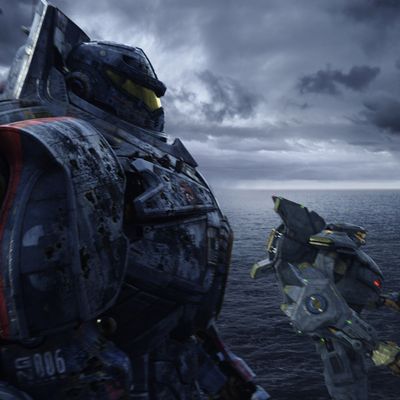
The Mexican-born director Guillermo del Toro evinces so much passion when he talks about genre — horror, fantasy, and sci-fi in film and fiction — that it’s hard to believe he managed to get so little emotion into his giant-robots-versus-giant-monsters epic, Pacific Rim. The movie isn’t bad. It has a couple of exciting scenes (I can’t really remember them, but I remember being excited) and one actor with more preternatural force than the monsters. It’s just weirdly inexpressive. Pacific Rim (a flat title, though a good setup for the inevitable porn version) doesn’t even have the charm of such Toho beanbags as Destroy All Monsters, War of the Gargantuas, or the underappreciated King Kong Escapes — in which Kong battles “MechaKong,” the creation of the dastardly Dr. Who (not the TARDIS one). Pacific Rim made me marvel at the technology of movies, but never the magic of them.
I think Del Toro goes wrong from the first line of the voice-over narration, when the nominal hero, Raleigh Becket (Charlie Hunnam), says he was 15 when the first kaiju (translation: giant f–king alien f—ing monster) emerged from a portal to another world in the middle of the sea. The story he goes on to tell — how Earth’s weapons were ineffectual and cities leveled, how scientists were finally able to design giant robots that had to be operated by mind-melded (pardon my Trekspeak) pilots — sounds as if it would make a fantastic movie. Imagine that first out-of-nowhere kaiju attack, the decisive failure of tanks and missiles, the frantic arms race as millions perish, the tragic mistakes (in which test pilots die horribly) before neuro-connectivity is achieved … Did I miss that movie? Or did Del Toro for reasons known only to him decide to make the overblown sequel first? It’s as if Michael Bay had skipped right to Transformers 2 without establishing his hero and giving us a baseline of normalcy.
After the aforementioned Pacific Rim 1 has been hastily synopsized, Pacific Rim 2 kicks off with an unprecedentedly deadly Pacific Rim expulsion. Whatever demon power is sending humongous whatzits up that subterranean canal, it has adapted to our killing techniques and modified its kaiju. Plus, it’s sending out two at time! Who knew it could do that? Could it possibly send three? Surely not. Raleigh and his brother, Yancy Becket (Diego Klattenhoff), are ace giant-robot (or jaeger) pilots, meaning they’re — all together now — jaegermeisters. But after they disobey orders to save a freighter, they get reamed.
Five years later, it looks bad for humankind but better for the movie with an uptick in screen time for boss-man Stacker Pentecost, played by Idris Elba. Forget The Wire, Luther, etc. If anything proves Elba is a major actor, it’s Pacific Rim. He can makes a ridiculously florid exhortation to his troops — “At the edge of our hope at the end of our time … ” — sound better than what Shakespeare offered Henry at Agincourt. Elba picks up this ten-ton barrel of silliness and carries it like Atlas on his back. In most films, scenes in which tight-ass superiors chastise maverick heroes for being mavericky are there to make the maverickness seem even more heroic. Elba makes you want to tell the mavericks to shut up and listen. He psychs Raleigh out and the audience, too. It’s a tragedy of cosmic proportions that he has no scenes with the movie’s only other good character, a mythically sleazy dealer in dead kaiju body parts called Hannibal Chau played by Ron Perlman. Perhaps their classic confrontation happened in Pacific Rim 1. In any case, Elba has little chemistry with the actors he does have scenes with — Hunnam and the little mangalike Japanese femme Mako Mori (Rinko Kikuchi), who’s eager to suit up and boot up and avenge the death of her family. Mori is cute and game and is capable of registering more than one emotion at a time. As her scene partner, Hunnam doesn’t have a lot to work with. He’s a good actor, but he’s blandified.
Del Toro is one of those directors (Christopher Nolan remains the Lord and Savior) who brings out the fanboys, ever eager to defend him (even before seeing the film in question) from the slings and arrows of critics who just don’t get it. Perusing the web, I’ve found comments like this after negative reviews: “You should know what you’re signing up for when you buy a ticket to this movie. Its [sic] a monsters vs robots movie. In my eyes, that is just a fun, entertaining time. You don’t have to be an 11 year old boy to appreciate this. Anyone can like a [sic] robots and monsters engaging in a smackdown.” I agree! But anyone who can geek out to Pacific Rim is doing a lot of the movie’s work for it. The compositions are boxy and the battles clanky and spatially incoherent — shot up close for extra punch but with so little breathing room in the frame that you lose all sense of scale. I almost never knew who (or what) was bashing whom (or what).
The film is better when it’s not so fast and furious, as in shots of choppers carrying (and landing) the colossal robots or of creatures emerging from the sea and only gradually revealing their odd shapes and protuberances. Gigantitude prompts awe. The wittiest design is of a kaiju fetus that erupts from its mother’s womb — also the film’s most organic design. Otherwise, Del Toro’s feel for organic textures doesn’t come through in a movie made mostly inside computers. Pacific Rim is a puzzler. It’s as if Del Toro neuro-linked with a robot and then couldn’t figure out how to work the controls — and so watched impotently as the machine made the major creative decisions.


